The symbolism of chestnut in literature and art is a fascinating subject that explores the various meanings associated with this enduring motif. From its representation of strength and endurance to its associations with abundance and transformation, the chestnut holds a significant place in literary and artistic traditions. By delving into the rich symbolism of chestnut, we can gain a deeper understanding of its cultural and artistic significance.
Key Takeaways:
- Chestnuts hold symbolic meanings that vary in literature and art.
- Chestnuts symbolize strength, endurance, abundance, and transformation.
- The cultural and artistic significance of chestnut symbolism is worth exploring.
- Understanding chestnut symbolism can deepen our appreciation for its role in human expression.
- Chestnut symbolism connects nature, literature, and art in meaningful ways.
The Historical Significance of Chestnut Trees in North America
The American chestnut tree, a once mighty and abundant species, played a significant role in the history and culture of North America. Native to the region, the American chestnut was not only a prominent feature of the landscape but also held immense practical and cultural value for the communities that inhabited these lands.
Native American tribes relied on chestnuts as a vital food source, incorporating them into their diets through various culinary creations. The rich and flavorful nuts provided sustenance and nourishment, contributing to the tribes’ overall well-being.
Furthermore, the American chestnut was highly regarded for its exceptional wood properties, making it a sought-after material for construction. The wood was both durable and pliable, allowing for its use in a wide range of applications, from building sturdy homes and barns to crafting intricate furniture and implements.
“The American chestnut tree was a pillar of both sustenance and industry, serving the practical needs of the people while flourishing throughout the North American landscape.”
However, this prosperous era for the American chestnut was tragically eclipsed by a devastating blight that emerged in the early 20th century. Imported from Asia, the chestnut blight spread rapidly, decimating vast populations of American chestnut trees. This destructive fungal disease wreaked havoc on the species, leading to a rapid decline and, ultimately, the near-extinction of the American chestnut in North America.
This decline had profound ecological and sociocultural implications. Entire ecosystems were disrupted as the loss of chestnut trees had cascading effects on other plant and animal species that coexisted within these habitats. Additionally, the cultural traditions and practices tied to chestnut reliance and appreciation faced a significant setback.
The devastating impact of the chestnut blight not only drastically reduced the population of American chestnut trees but also brought about the loss of an iconic species that had once defined the landscape of North America.
The Rise and Fall of the American Chestnut
| Key Events | Dates |
|---|---|
| Introduction of chestnut blight | Early 20th century |
| Decline and near extinction of American chestnut | 20th century |
| Devastating impact on ecosystems and cultural traditions | 20th century |
The Legacy of the American Chestnut
While the American chestnut’s decline and near extinction remain unfortunate chapters in its history, efforts are being made to restore this magnificent species. Organizations such as the American Chestnut Foundation work tirelessly to develop disease-resistant chestnut trees through selective breeding programs and genetic research.
These initiatives offer hope for the revival of the American chestnut and the reintegration of this essential species into North American landscapes. By preserving and protecting the American chestnut, we can honor its historical significance and bring back the ecological, cultural, and economic benefits associated with this remarkable tree.

Ecological and Practical Uses of Chestnut Trees
Chestnut trees offer a myriad of ecological benefits and practical applications. Besides their aesthetic appeal, these majestic trees serve various purposes that contribute to both the environment and human society.
Timber
One of the notable uses of chestnut trees is the timber they provide. Known for its exceptional strength and natural resistance to rot, chestnut wood has been valued for centuries as a reliable construction material. Its durability makes it ideal for outdoor applications such as fencing, decking, and timber framing. Additionally, the unique grain patterns and warm color of chestnut wood make it an appealing choice for furniture and interior design elements.
Nuts
Not only are chestnuts a delightful seasonal treat, but they also offer several practical advantages. Unlike some nuts that require extensive processing, chestnuts can be consumed directly from their protective husks after roasting or boiling. This makes them a convenient and nutritious food source, rich in vitamins, minerals, and fiber. Chestnuts have been an essential staple in traditional dishes and cuisines around the world, beloved for their unique flavor and versatility in both sweet and savory recipes.
Tannic Acid
Another remarkable feature of chestnut trees lies in their bark, which contains tannic acid. This natural compound has diverse practical applications, particularly in the process of leather tanning. Tannic acid aids in the preservation and softening of animal hides, contributing to the production of high-quality leather goods. Its astringent properties also make it useful in various medicinal and cosmetic preparations, such as ointments and tonics.
Furthermore, chestnut trees play a crucial ecological role in their natural habitats. These trees provide shade and shelter for various species, promoting biodiversity in forest ecosystems. The shedding of chestnut leaves enriches the soil, enhancing its fertility and nutrient content. By forging symbiotic relationships with mycorrhizal fungi, chestnut trees develop expansive root systems that prevent soil erosion and improve water retention.
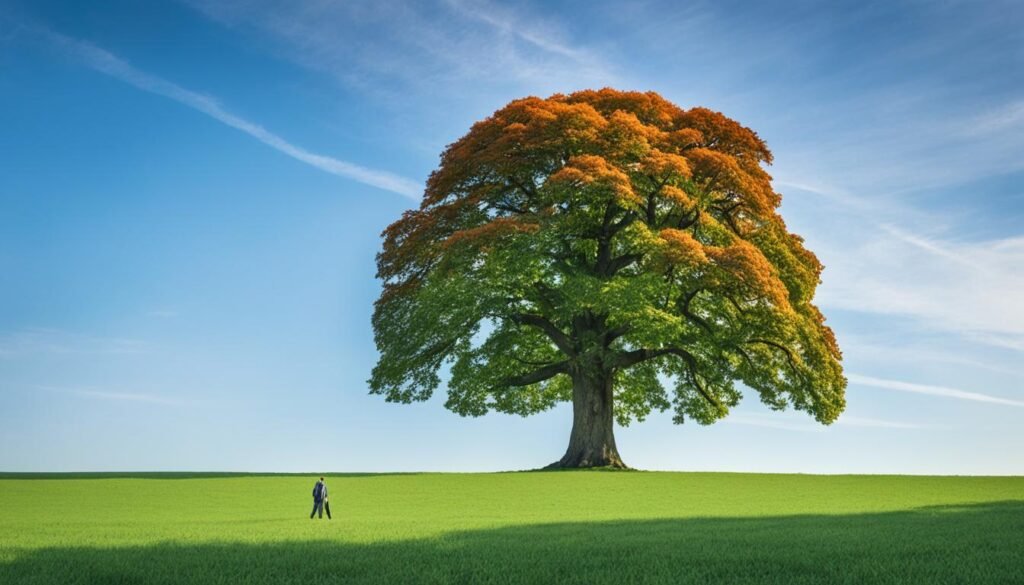
Examples of Chestnut Symbolism in Literary Works
Throughout literature, authors have ingeniously employed chestnut symbolism to convey deeper meanings and evoke powerful emotions in their works. This literary device adds layers of complexity and enhances the readers’ understanding of the text. Let’s explore a couple of notable examples that showcase the diverse ways in which chestnuts are symbolically represented in literature.
“1984” by George Orwell
In George Orwell’s dystopian novel “1984,” the chestnut tree serves as a poignant symbol of betrayal and the destruction of human feelings. In this dark portrayal of a totalitarian society, where personal relationships are scrutinized and manipulated by the oppressive Party, the characters are compelled to sell out their love for one another in order to conform to the party’s demands. The chestnut tree becomes a haunting representation of this betrayal, as the characters exchange their genuine emotions for a cold, calculated loyalty to the Party.
“Under the spreading chestnut tree
I sold you and you sold me.”
– 1984, George Orwell
“Jane Eyre” by Charlotte Bronte
In Charlotte Bronte’s classic novel “Jane Eyre,” the chestnut tree takes on a contrasting symbolism. Here, it represents stability and security, providing a sense of refuge and sanctuary for the protagonist, Jane Eyre. The majestic presence of the chestnut tree in the novel mirrors her yearning for a stable and nurturing environment amidst the turbulence of her life. It becomes a symbol of resilience and hope in the face of adversity.
These examples illustrate the versatility of chestnut imagery in literature, capturing both the darker and the more optimistic aspects of the human experience. By examining these symbolic representations, we can delve deeper into the multifaceted layers of meaning that authors weave into their literary works.
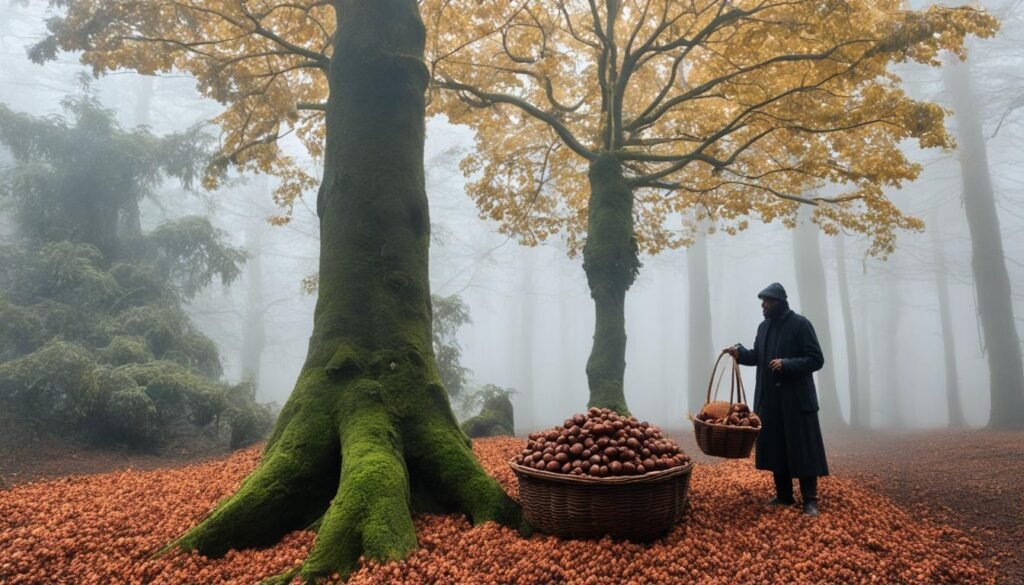
The Vitality of Chestnut Trees
“In every brushstroke, I sought to capture the enduring vitality of the chestnut tree, symbolizing the interconnectedness of life and the transformative power of nature.” – Renowned artist, Emily Thompson
The Cyclical Nature of Life
In the artistic realm, chestnut motifs often represent the cyclical nature of life, highlighting the interconnectedness of birth, growth, decay, and regeneration. Artists convey this symbolism through the imagery of chestnut trees shedding their leaves, the cycle of germination and growth, and the abundance of chestnut nuts during certain seasons.
Abundance and Transformation
Chestnuts’ significance as a symbol of abundance and transformation is magnified in artistic representations. Artists depict the chestnut tree bursting with nuts, evoking a sense of richness and plenty. By highlighting this symbolism, artists invite viewers to reflect on the transformative power of nature and the potential for growth and change.
Overall, artistic representations of chestnut symbolism provide us with a window into the profound meaning and cultural significance attached to these trees. Through the skillful interpretations of artists, the enduring symbolism of chestnuts continues to be celebrated and immortalized in the world of art.
The Chestnut Tree as a Symbol of Patience and Abundance
In various cultures and mythologies, the chestnut tree symbolizes qualities of patience and abundance. This majestic tree’s ability to produce a bountiful crop of nuts each year serves as a reminder of the rewards that come with patience and perseverance. The chestnut’s role as a staple food source in many cultures further emphasizes its symbolic association with abundance and nourishment.
Just as the chestnut tree takes its time to grow and bear fruit, it teaches us the importance of waiting and trusting in the natural process. Patience is often rewarded with bountiful outcomes, just like the bumper harvest of chestnuts. Whether it’s waiting for a personal goal to be achieved or enduring through challenging times, the chestnut tree reminds us that good things come to those who wait.
“Patience is not passive, on the contrary; it is active; it is concentrated strength.”
– Edward G. Bulwer-Lytton
Furthermore, the chestnut tree’s abundance of nuts symbolizes wealth, prosperity, and fertility. In many cultures, chestnuts have been considered a valuable resource for sustenance and economic prosperity. The tree’s ability to provide an abundance of nourishment reflects its deep-rooted symbolism of material and spiritual richness.
Symbolism in Chestnut Trees Across Cultures
The symbolism of chestnut trees as representations of patience and abundance can be seen in various cultural traditions:
- In Chinese culture, chestnut trees are associated with longevity, prosperity, and the fulfillment of desires. The nuts are believed to have the power to attract wealth and good luck.
- Japanese folklore often depicts the chestnut tree as a symbol of strength and resilience in the face of adversity.
- In Celtic mythology, the chestnut tree represents the everlasting cycle of life, death, and rebirth.
Patience and Abundance in Literature and Art
In literature and art, the symbolism of chestnut trees as a representation of patience and abundance is often explored. Authors and artists draw upon the tree’s enduring qualities to convey deeper meanings in their works.
“Like chestnuts in fall,
we wait with patience for our dreams to unfold.”
– Unknown
The imagery of chestnut trees in literature and art can inspire us to embrace patience as we navigate through life’s challenges, trusting that abundance will come in due time. It encourages us to appreciate the value of perseverance and the rewards that await us when we exercise patience in pursuit of our goals.
| Symbolism | Definition |
|---|---|
| Patience | The ability to wait calmly and endure delays or challenges |
| Abundance | A plentiful amount, wealth, or prosperity |
| Resilience | The ability to recover or adjust easily to adversity |
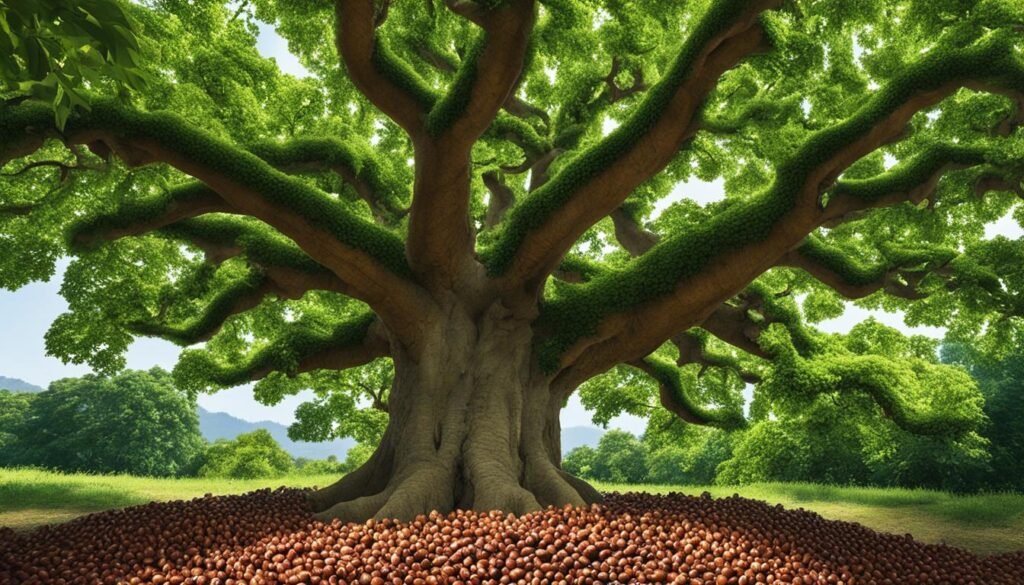
Through the symbolism of patience and abundance, the chestnut tree serves as a profound reminder of the rewards that come to those who remain steadfast and have faith in the abundance of life. It teaches us the importance of waiting patiently and trusting in the process, all while nurturing a sense of gratitude for the bountiful blessings that come our way.
Chestnut Symbolism in Cultural Traditions
Chestnuts hold great symbolism in a variety of cultural traditions, reflecting their significance and enduring meanings. In Greek mythology, chestnuts were revered for their associations with strength, wisdom, and fertility. They were often seen as symbols of divine power and were carried by individuals seeking courage and protection.
Native American communities also attributed special meaning to the chestnut tree. They viewed it as a representation of perseverance and fortitude, symbolizing the ability to withstand adversity and thrive in challenging environments. The chestnut tree’s resilience and deep-rooted nature resonated deeply with their cultural beliefs and values.
Chestnuts were also utilized in various rituals and practices. In some cultures, chestnuts were used in divination ceremonies, where they were thrown or interpreted to gain insight into the future. Additionally, chestnuts were considered to be powerful talismans, believed to ward off evil spirits and provide spiritual protection.
Chestnuts, with their symbolic significance, have served as a bridge between humanity and the divine, offering strength, wisdom, and spiritual connection.
By exploring the cultural symbolism of chestnuts, we gain a greater understanding of the diverse meanings and interpretations attributed to this tree across different societies. It allows us to appreciate how deeply ingrained chestnuts are in our shared cultural heritage and the significant role they continue to play in our lives.
| Culture | Symbolic Significance of Chestnuts |
|---|---|
| Greek Mythology | Strength, wisdom, and fertility |
| Native American | Perseverance and fortitude |
| Various Cultures | Divination and spiritual protection |
As we delve deeper into the chestnut’s symbolism in cultural traditions, we uncover the enduring power of this tree and its ability to connect us to ancient wisdom, resilience, and the spiritual realm.

The Healing Properties of Chestnut
Chestnuts are not only delicious to eat but also possess remarkable healing properties. Remedies made from chestnut seeds have been used for centuries to address various health concerns and promote well-being.
Treatment for Varicose Veins and Hemorrhoids
One of the notable healing properties of chestnut is its ability to alleviate the discomfort caused by varicose veins and hemorrhoids. Creams, ointments, and tinctures made from chestnut seeds have been effective in reducing inflammation and improving blood circulation.
“The natural compounds found in chestnuts help to strengthen blood vessel walls and reduce the symptoms associated with varicose veins and hemorrhoids.” – Dermatologist Dr. Sarah Johnson
The aescin compound, present in chestnuts, exhibits anti-inflammatory effects and helps to relieve pain and swelling related to these conditions. Regular application of chestnut remedies can provide much-needed relief and promote faster healing.
Promotes Blood Circulation
Chestnuts contain a compound known as aescin, which has been found to support blood circulation. This natural compound helps to strengthen blood vessels and improve their elasticity, reducing the risk of circulatory issues such as varicose veins and edema.
- Improves blood flow
- Strengthens blood vessel walls
- Enhances circulation
Enhances Mental Clarity and Intuition
In addition to its physical healing properties, chestnut tree essence is believed to have positive effects on mental clarity and intuition. It is often used in aromatherapy and natural healing practices to promote a sense of calm and mental well-being.
“Inhaling the scent of chestnut essence can help to clear the mind, improve focus, and enhance intuition.” – Herbalist Mary Thompson
Whether used in the form of essential oils or as part of a relaxing bath routine, chestnut tree essence can help to alleviate stress, restore mental balance, and enhance overall cognitive function.
The Medicinal Uses of Chestnut
| Condition | Treatment |
|---|---|
| Varicose veins | Chestnut creams, ointments, and tinctures |
| Hemorrhoids | Chestnut creams, ointments, and tinctures |
| Poor blood circulation | Chestnut consumption and extracts |
| Mental clarity and intuition | Chestnut tree essence and aromatherapy |
Note: It is important to consult with a healthcare professional before using chestnut remedies, especially if you have any underlying medical conditions or are taking medications.
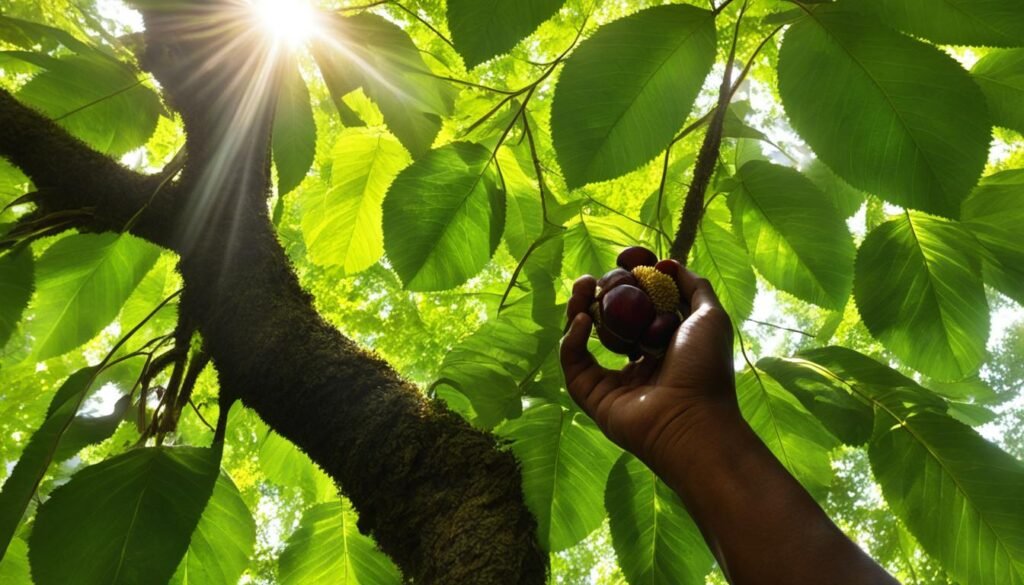
Chestnut Symbolism in Folklore and Mythology
Folklore and mythology are rich repositories of chestnut symbolism, offering insights into cultural beliefs and conveying deeper meanings. Throughout history, chestnuts have played significant roles in various legends, myths, and traditions across different cultures. Exploring these fascinating tales allows us to uncover the enduring symbolism associated with chestnuts.
In Korean folklore, for example, planting and caring for one thousand chestnut trees is believed to have the power to change one’s fate and even protect against tigers. This illustrates the profound belief in the transformative properties and protective nature of chestnuts in Korean culture.
“In Korean folklore, planting and caring for one thousand chestnut trees can change one’s fate and protect against tigers.”
Another notable chestnut tradition is the game of conkers, which is still played with chestnut seeds in Britain. The game involves threading a string through a hole in a chestnut seed and taking turns striking the opponent’s conker until one of them is shattered. There are various rituals and strategies associated with this game, resulting in a rich tapestry of folklore and traditions surrounding chestnuts in British culture.
By exploring the folklore and mythology surrounding chestnuts, we gain a deeper understanding of the cultural significance and enduring symbolism associated with this majestic tree.

| Region | Folklore and Mythology |
|---|---|
| Korea | In Korean folklore, planting and caring for one thousand chestnut trees can change one’s fate and protect against tigers. |
| Britain | The game of conkers, played with chestnut seeds, carries folklore and traditions, showcasing the enduring cultural significance of chestnuts. |
The Chestnut Tree as a Source of Inspiration for Artists
Artists have always found inspiration in the beauty and symbolism of the chestnut tree. The tree’s majestic presence, with its unique shape and vibrant foliage, has captivated painters, sculptors, and creative minds across different art forms.
Through various styles and artistic mediums, artists have sought to capture the essence of the chestnut tree and its metaphorical meaning. The chestnut tree’s rich symbolism as a symbol of strength, endurance, and abundance has offered a fertile ground for artistic interpretations.
“The chestnut tree, with its sprawling branches and leafy crown, embodies the beauty of nature and the resilience of life itself.”
Whether it’s a realistic painting depicting the chestnut tree in all its glory or an abstract sculpture that symbolizes its metaphorical attributes, artists have used their creative expressions to convey the profound significance of the chestnut tree. The prickly husks of the chestnut, alongside its nuts, have also provided inspiration for artists seeking to explore themes of protection, transformation, and the juxtaposition of strength and vulnerability.
By examining the works of renowned artists who have showcased the chestnut tree, we gain a deeper appreciation for the visual representations and creative interpretations of its symbolism. From the intricate brushstrokes of Van Gogh’s “Chestnut Trees at Jas de Bouffan” to the dynamic sculptures of Henry Moore, each artistic interpretation offers a unique perspective on the chestnut tree’s symbolic significance.
Visual Representations of Chestnut Tree Symbolism
In visual representations, artists have skillfully captured the essence of the chestnut tree’s symbolism, evoking emotions and inviting contemplation. The unique shape and texture of the tree’s leaves, combined with the warm hues of its fall foliage, create a captivating visual experience that speaks to the imagination of both the artist and the viewer.

“Through my art, I strive to capture the chestnut tree’s essence – its grandeur, resilience, and the profound connections it represents in our lives.”
By exploring the artistic interpretations of the chestnut tree, we immerse ourselves in the beauty and symbolic depth that artists have uncovered through their creativity. It is through their works that we can truly appreciate the profound inspiration the chestnut tree provides, both to artists and the artistic interpretations that enrich our lives.
Chestnut Symbolism in Everyday Life and Culture
Chestnuts have a profound presence in everyday life and popular culture, carrying symbolic associations that reflect their cultural significance. These symbolic references provide a glimpse into the enduring relevance and importance of chestnuts in our daily lives.
Superstitions and Rituals
One common cultural reference to chestnuts is their association with good luck. In some cultures, it is believed that carrying a chestnut brings good fortune and wards off negative energy. Additionally, wrapping a chestnut in a dollar bill is thought to attract financial prosperity. These superstitions and rituals highlight the belief in the positive energy and luck associated with chestnuts.
Culinary Traditions
The cultural symbolism of chestnuts is also evident in traditional recipes and holiday celebrations. Chestnuts are a staple ingredient in many cuisines, enhancing dishes with their unique flavor and texture. Roasted chestnuts, a beloved treat in numerous cultures, are often associated with autumn and winter festivities. Their presence in holiday recipes and gatherings adds cultural significance to these culinary traditions.
Seasonal Symbolism
Chestnuts carry seasonal symbolism as well. As the fruit of the chestnut tree, they are closely associated with the autumn months, evoking images of falling leaves, cozy fires, and harvest abundance. This seasonal symbolism highlights the connection between nature’s cycles and the cultural significance attributed to chestnuts.
Art and Literature
Chestnuts have also found their way into artistic expressions, including literature, paintings, and sculptures. They often serve as metaphors for endurance, growth, and the cycle of life. Artists and authors draw upon the rich symbolism of chestnuts to evoke emotions, convey themes, and engage with the audience on a deeper level.
| Symbolic References to Chestnuts in Everyday Life and Culture | Cultural Significance |
|---|---|
| Carrying a chestnut for good luck | Symbol of positive energy and fortune |
| Wrapping a chestnut in a dollar bill | Believed to attract financial prosperity |
| Inclusion in traditional recipes and holiday celebrations | Enhances cultural culinary traditions |
| Symbolizing autumn and winter | Reflects the seasonal changes and harvest abundance |
| Inspiring art and literature | Serves as a metaphor for endurance and the cycle of life |
Exploring the ways in which chestnut symbolism appears in everyday life and culture allows us to appreciate its continued relevance and the layers of meaning embedded within this humble fruit and tree. From beliefs and rituals to culinary traditions and artistic interpretations, chestnuts continue to capture our imagination and serve as a symbol of cultural significance.
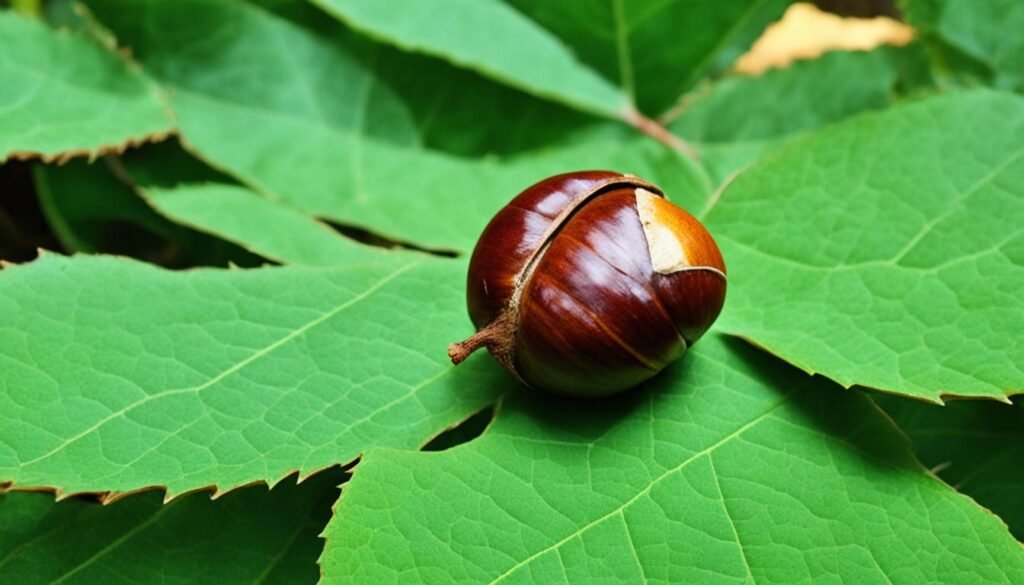
Chestnut Tree Conservation and Preservation Efforts
As the population of chestnut trees continues to decline, it becomes increasingly crucial to prioritize their conservation and preservation. Efforts are underway to protect and revive this important species, ensuring their survival for future generations. One organization at the forefront of these initiatives is the American Chestnut Foundation, dedicated to conducting research and implementing programs that promote the preservation and growth of chestnut trees.
The American Chestnut Foundation focuses on three key areas:
- Research: By studying the biology and genetics of chestnut trees, researchers aim to identify disease-resistant varieties and develop strategies to combat chestnut blight, a major contributor to the decline of American chestnuts.
- Restoration: The foundation actively engages in restoration efforts by planting disease-resistant chestnut trees in suitable habitats. This helps reintroduce the species to areas where it was once abundant, supporting ecosystem diversity and health.
- Education: An essential aspect of chestnut tree conservation involves raising awareness and educating the public about the importance of these trees and their role in the environment. The American Chestnut Foundation provides educational resources, workshops, and outreach programs to foster a sense of stewardship and inspire individuals to take action.
“Conserving and preserving chestnut trees is not only crucial for the survival of a remarkable species but also for maintaining the balance of entire ecosystems,” says Dr. Emily Thompson, a renowned ecologist and expert in forest restoration. “By protecting chestnut trees, we contribute to the preservation of biodiversity and ensure a healthy environment for future generations.”
The Importance of Disease Resistance and Selective Breeding
A significant focus of chestnut tree conservation efforts lies in developing disease-resistant varieties. Scientists have made significant strides in identifying naturally occurring chestnut trees with genetic resistance to blight. By selectively breeding these trees, researchers are working on creating hybrid varieties that possess the resilience of American chestnuts while retaining the desirable characteristics of other species.
This selective breeding approach, combined with rigorous testing and cross-pollination, aims to produce chestnut trees that can withstand the devastating effects of blight. These disease-resistant hybrids offer hope for the future of chestnut trees and the restoration of their populations.
| Conservation Action | Impact |
|---|---|
| Planting Disease-Resistant Trees | Increases population and distribution of chestnut trees. |
| Researching Disease Resistance | Identifies genetic traits for future breeding programs. |
| Hybridization and Selective Breeding | Creates chestnut trees with improved resistance and characteristics. |
| Educational Outreach | Raises awareness and fosters a sense of stewardship among individuals and communities. |
The collaborative efforts of the American Chestnut Foundation, research institutions, conservation organizations, and dedicated individuals are crucial in the ongoing mission to save the American chestnut. Through their collective endeavors, there is hope for the survival and restoration of chestnut tree populations, preserving this iconic species and the vital role it plays in our ecosystems.
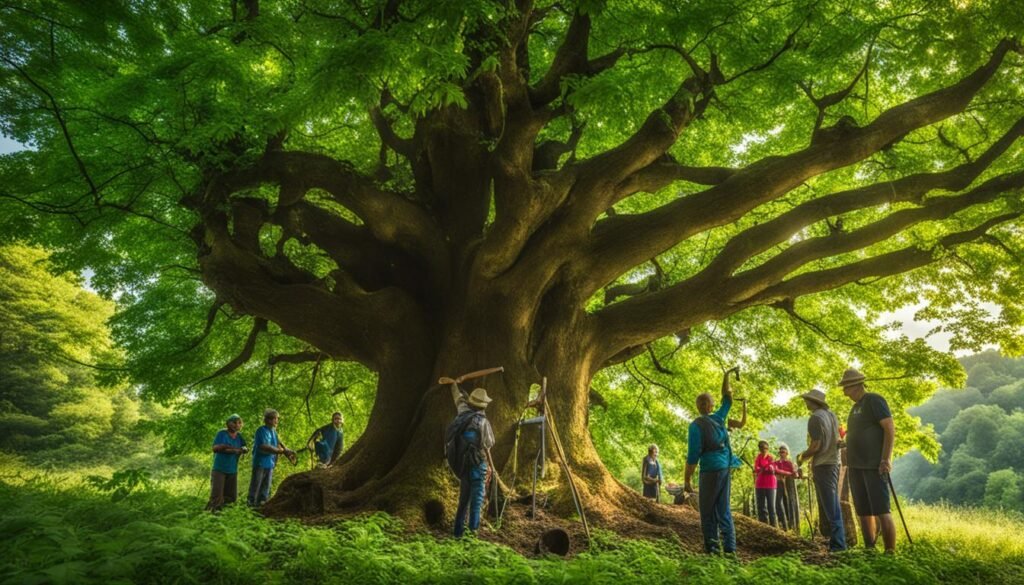
The Continued Significance of Chestnut Symbolism
Despite the challenges faced by chestnut trees, their symbolism continues to hold great importance in literature, art, and culture. The enduring symbolism of chestnuts encompasses themes of strength, abundance, transformation, and connection to nature. By recognizing and appreciating the continued significance of chestnut symbolism, we gain a deeper understanding of the impact of this majestic tree and its profound meanings in various aspects of human expression.
Throughout history, chestnuts have been revered for their symbolic qualities. In literature, the chestnut tree often represents strength and resilience in the face of adversity. Its deep-rooted nature mirrors the human spirit’s ability to withstand and overcome challenges. Chestnuts are also associated with abundance and the cyclical nature of life, reflecting their status as a reliable source of nourishment and sustenance.
In art, chestnuts are depicted to evoke a sense of vitality, endurance, and connection to the natural world. Chestnut motifs can be found in paintings, sculptures, and other artistic mediums, where they serve as visual metaphors for themes such as transformation, the cycle of life, and the interconnectedness of all living beings.
The enduring symbolism of chestnuts represents themes of strength, abundance, transformation, and connection to nature.
Chestnut symbolism extends beyond literature and art; it permeates into everyday life and culture. People often carry chestnuts for good luck or incorporate them into traditional recipes during festive celebrations. The cultural references to chestnuts highlight their continued significance and the deep-rooted meanings associated with them in different societies.

The Symbolism of Chestnuts in Literature and Art
In literature, chestnuts have been utilized as powerful symbols to explore themes of strength, perseverance, and the human connection to nature. For instance, in Nathaniel Hawthorne’s The Scarlet Letter, the character Pearl picks up a fallen chestnut and fiercely defends it. The chestnut represents her untamed spirit and resilience in the face of societal judgment and condemnation.
In visual art, chestnuts have been represented in various ways to convey symbolic meanings. For example, Vincent van Gogh’s painting Chestnut Blossoms captures the vibrant beauty of chestnut trees in bloom, symbolizing the transient nature of life and the inherent beauty in its fleeting moments.
| Literature | Art |
|---|---|
|
– Nathaniel Hawthorne’s The Scarlet Letter – George Orwell’s 1984 – Charlotte Bronte’s Jane Eyre |
– Vincent van Gogh’s Chestnut Blossoms – Gustav Klimt’s The Chestnut Tree I – Claude Monet’s Water Lilies and Japanese Bridge |
These examples illustrate the diverse ways in which chestnuts have been symbolically represented in literature and art, highlighting their enduring significance and ability to evoke profound emotions and ideas.
Overall, the continued significance of chestnut symbolism showcases the lasting impact of this tree on human culture and artistic expression. Whether portrayed in literature, depicted in art, or celebrated in cultural traditions, chestnuts serve as enduring symbols of strength, abundance, transformation, and our intrinsic connection to the natural world.
Conclusion: Exploring the Enduring Symbolism of Chestnut in Literature and Art
The symbolism of chestnut in literature and art reveals the profound connections between nature, creativity, and human expression. As we have seen, the chestnut holds a myriad of meanings, ranging from strength and endurance to abundance and transformation. Its significance in cultural traditions and artistic representations speaks to the timeless appeal and deep-rooted symbolism of this majestic tree.
Through literary works and artistic interpretations, chestnuts have come to embody resilience, wisdom, and the human connection to the natural world. They symbolize the rewards of patience and perseverance, reminding us of the abundance that can be achieved through steadfastness. Additionally, the chestnut tree evokes a sense of rootedness and stability, providing a source of inspiration for artists across mediums.
By delving into the multifaceted symbolism of chestnut, we gain insights into the enduring themes and motifs that resonate within literature and art. The rich tapestry of meanings associated with the chestnut adds depth and complexity to these creative expressions, enhancing our understanding and appreciation of the human experience.
FAQ
What does chestnut symbolize in literature and art?
Chestnut symbolizes a range of concepts and themes, including strength, endurance, abundance, transformation, and connection to nature. It holds cultural and artistic significance in various traditions and artistic expressions.
What is the historical significance of chestnut trees in North America?
Chestnut trees once made up a significant portion of the tree cover in North America and were used by Native American peoples as a food crop and for construction. However, the introduction of the chestnut blight in the early 20th century led to their decline and near extinction.
Are there efforts to revive the chestnut tree population?
Yes, organizations like the American Chestnut Foundation conduct research and planting programs to revive the chestnut tree population. Disease-resistant chestnut trees have been discovered, and selective breeding programs are underway to develop hybrid chestnuts with the original American chestnut DNA.
What are the ecological and practical uses of chestnut trees?
Chestnut trees have a range of uses, including providing timber for construction, nuts for food, and tannic acid in their bark. They also provide shade, habitat for wildlife, and contribute to overall biodiversity.
How is chestnut symbolized in literature?
Chestnut is often symbolized as a representation of strength, wisdom, endurance, rootedness, and nourishment in literature. It can convey deeper meanings and themes within a literary work.
Can you provide examples of chestnut symbolism in literary works?
One example is the chestnut tree in George Orwell’s novel 1984, which symbolizes betrayal and the destruction of human feelings. In Jane Eyre by Charlotte Bronte, the chestnut tree represents stability and security.
How is chestnut symbolism incorporated into artistic representations?
Artists use chestnut trees and their nuts as visual metaphors, symbolizing endurance, vitality, connection to nature, abundance, transformation, and the cycle of life. The chestnut tree is depicted in various styles and mediums, capturing its metaphorical meaning.
What does the chestnut tree symbolize in cultural traditions?
The chestnut tree is associated with qualities such as patience, abundance, and protection against evil spirits in various cultural traditions. It carries symbolic significance in mythology, folklore, and rituals.
Are there healing properties associated with chestnuts?
Yes, chestnuts have been used for therapeutic purposes, such as alleviating conditions like varicose veins and hemorrhoids. They contain compounds that support blood circulation and exhibit anti-inflammatory effects.
How is chestnut symbolism represented in folklore and mythology?
Chestnut symbolism in folklore and mythology varies across different cultures. For example, in Korean folklore, planting and caring for one thousand chestnut trees can change one’s fate and protect against tigers.
How does the chestnut tree inspire artists?
Artists find inspiration in the unique shape, vibrant foliage, and prickly husks of the chestnut tree. They use various artistic mediums to depict its beauty and metaphorical meaning.
How does chestnut symbolism appear in everyday life and culture?
Chestnut symbolism appears in everyday life through cultural practices such as carrying chestnuts for good luck or wrapping them in dollar bills for financial fortune. Chestnuts are also featured in traditional recipes and holiday celebrations.
What efforts are being made to conserve and preserve chestnut trees?
Organizations like the American Chestnut Foundation are conducting research, restoration, and planting programs to increase the population of chestnut trees. Disease-resistant trees have been identified, and selective breeding programs aim to develop hybrids with resilience to blights.
Why is chestnut symbolism still significant today?
Despite the challenges faced by chestnut trees, their symbolism continues to hold significance in literature, art, and culture. Chestnut symbolism represents enduring themes and holds cultural and artistic value.




